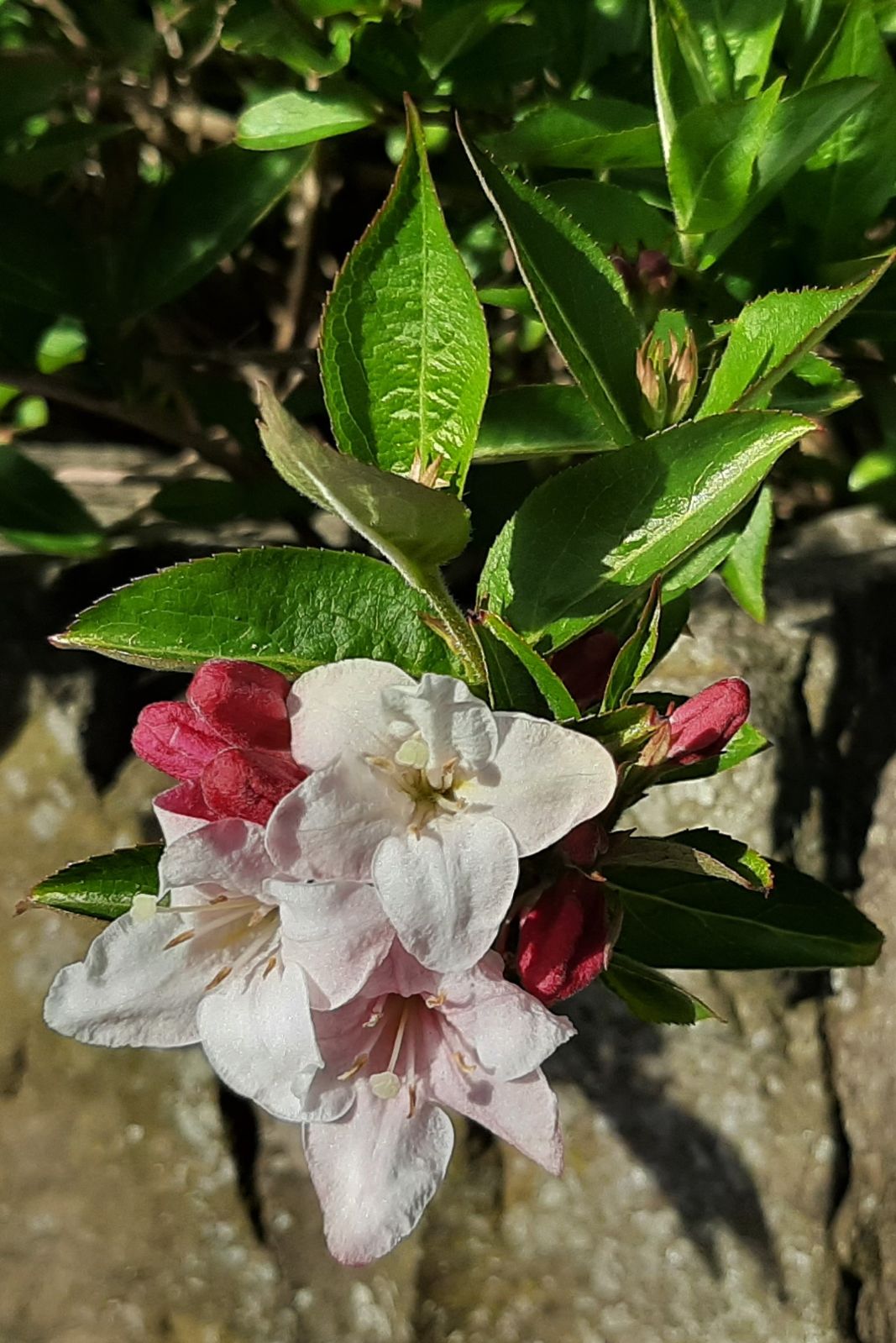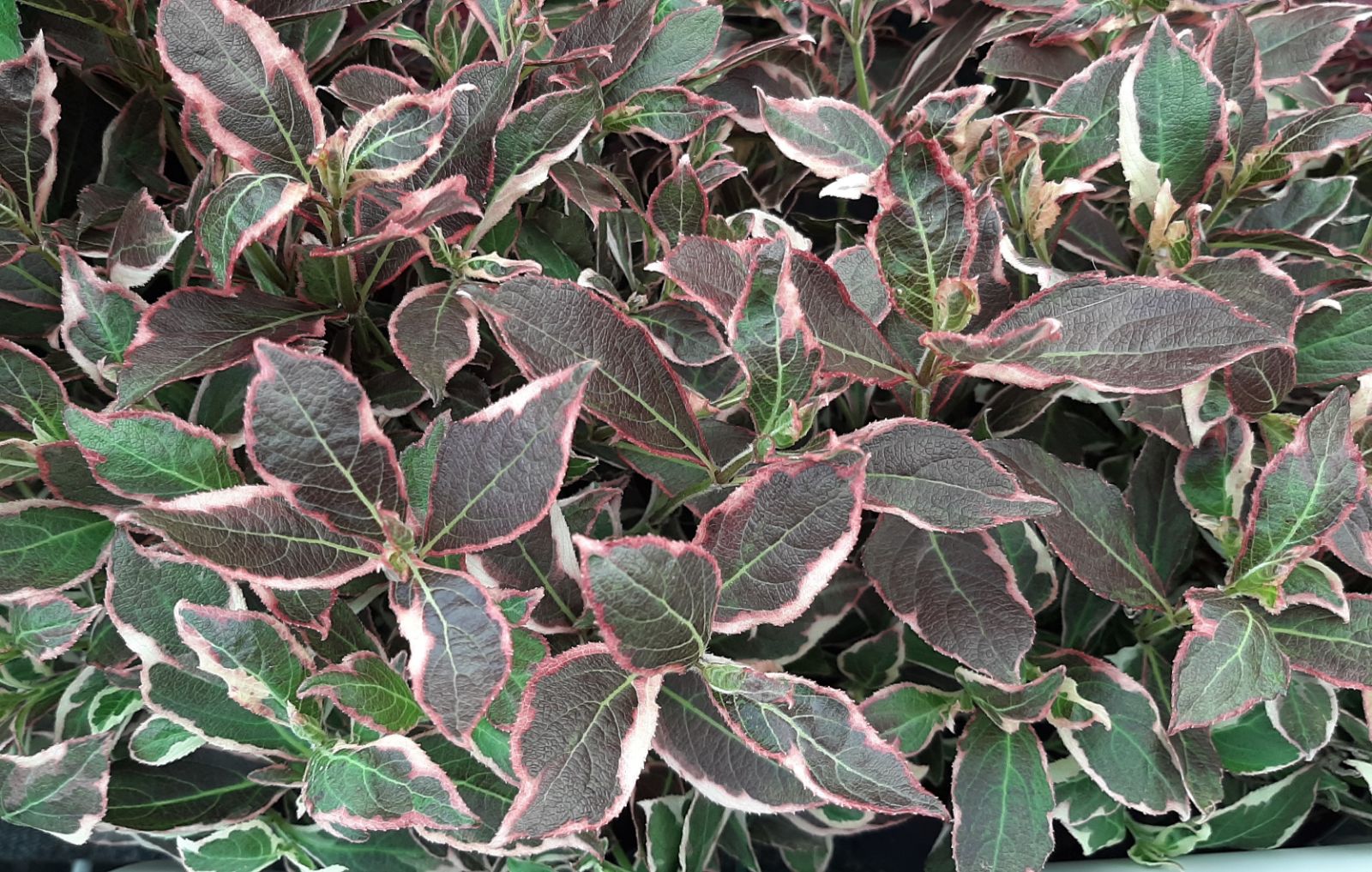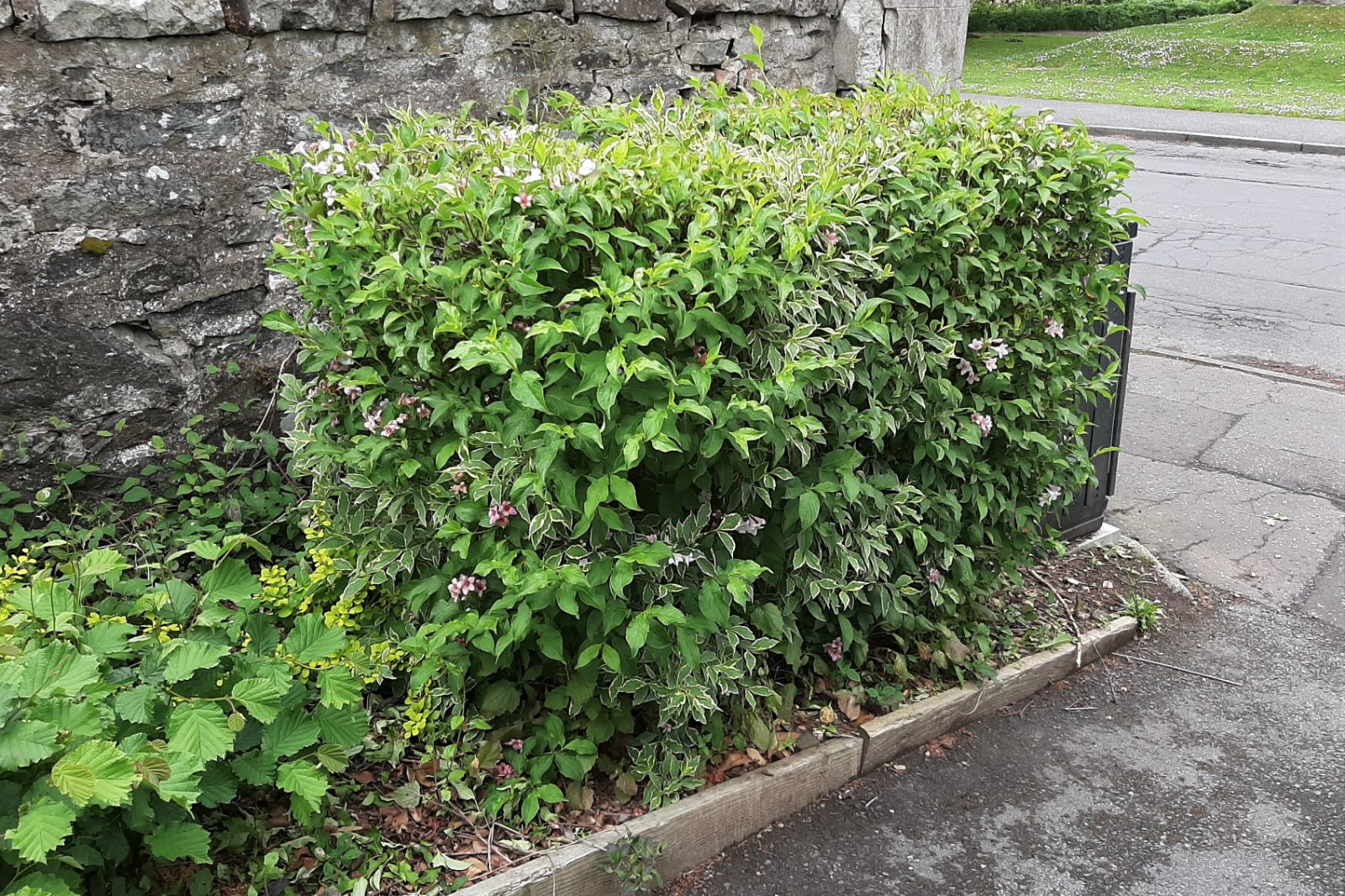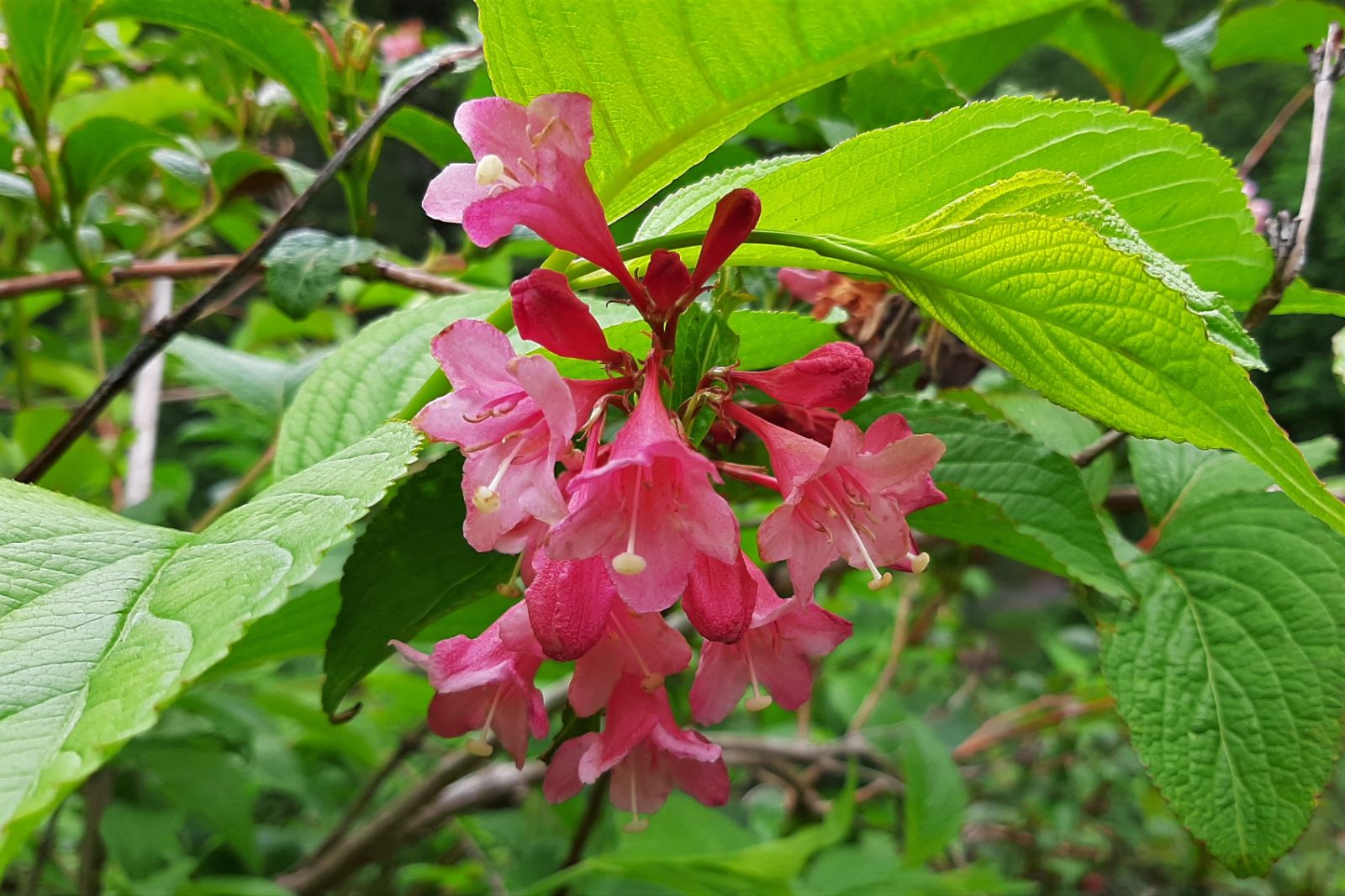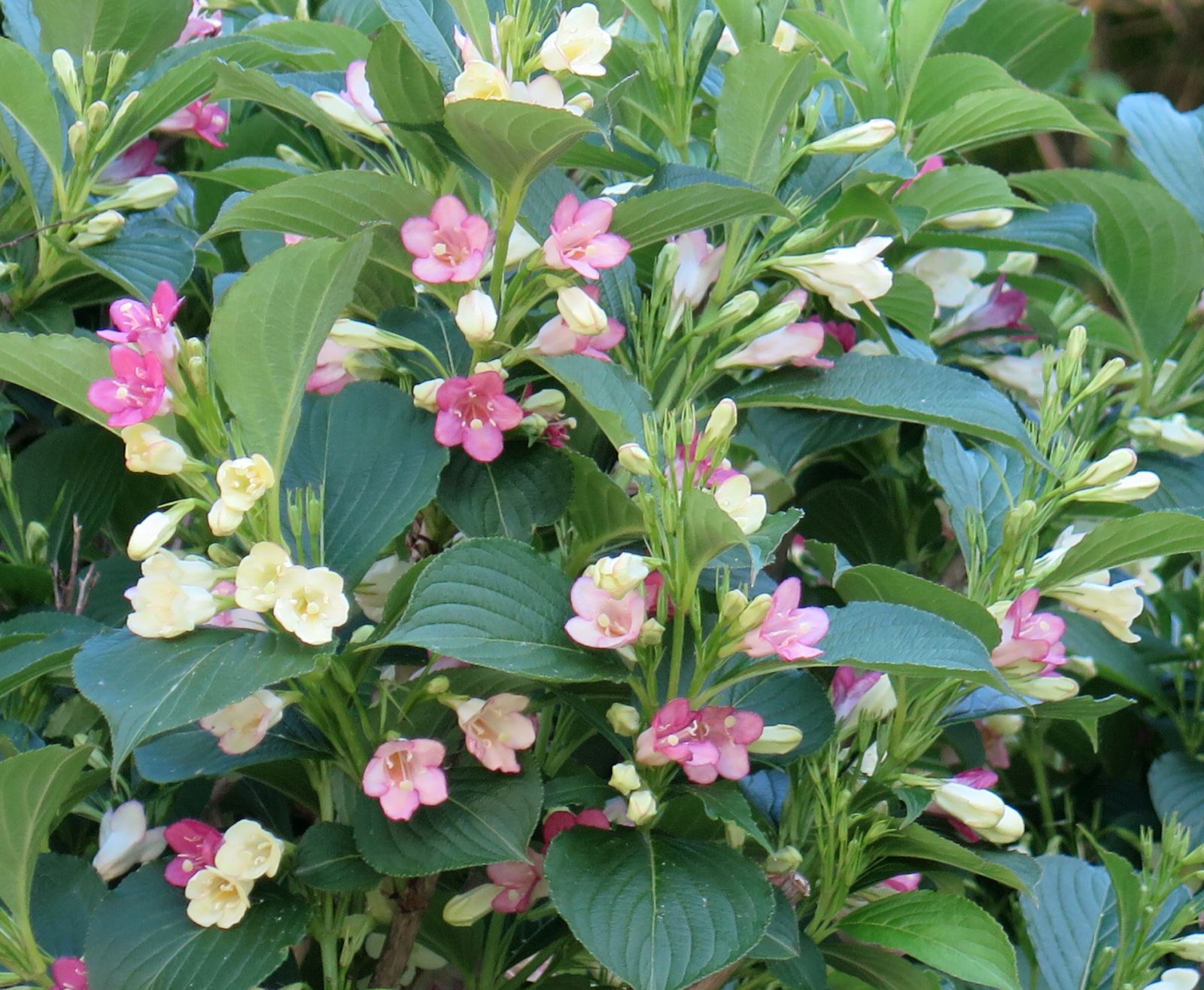Weigela
Sponsor
Kindly sponsored by
The Normanby Charitable Trust
Credits
Tom Christian & Alan Elliott (2019)
Recommended citation
Christian, T. & Elliott, A. (2019), 'Weigela' from the website Trees and Shrubs Online (treesandshrubsonline.
Family
- Caprifoliaceae
Species in genus
- Weigela Aurea Group
- Weigela Bicolor Group
- Weigela coraeensis
- Weigela decora
- Weigela Dwarf Group
- Weigela floribunda
- Weigela florida
- Weigela hortensis
- Weigela japonica
- Weigela maximowiczii
- Weigela middendorffiana
- Weigela Pink-Flowered Group
- Weigela Purpurea Group
- Weigela Red-Flowered Group
- Weigela subsessilis
- Weigela Variegata Group
- Weigela White-Flowered Group
Deciduous small trees or shrubs to 5 m. Branches angular when young, hairy or glabrous. Leaves with a very short (or almost absent) to longer petioles. Flowers solitary or 2–3 in cymes, on lateral short shoots borne on the previous year’s growth or at branch tips. Calyx tube narrowly cylindric; bilaterally or radially symmetric, 5-lobed, free to the middle or nearly to the base. Corolla tube narrow at base, widening abruptly or gradually; shallowly 5-lobed, bilaterally or radially symmetric, often hairy outside, white, or yellow, or pink , or red, or crimson. Stamens shorter, the same length or slightly longer than the corolla; style slender, longer than or the same length as the corolla tube. Stigma disc-like or cap-like. Fruit capsule dehiscing from apex. Seeds with angled ridges or narrowly winged (Iwatsuki (ed) 1993; Lee 2002).
There is very little consensus taxonomy when it comes to exactly which species of Weigela are accepted. There also does not appear to be any recent species level phylogeny of Weigela, the last being Kim, Young & Kim, Sung-Hee. (1999), Phylogeny of Weigela and Diervilla (Caprifoliaceae) Based on Nuclear rDNA ITS Sequences: Biogeographic and Taxonomic Implications. Journal of Plant Research. 112. 331–341.
We have therefore opted to follow the Flora of Japan (Iwatsuki (ed) 1993) as most species occur there.
We treat Chinese-derived material of W. japonica as a distinct variety, W. japonica var. sinica. This taxon was treated as a synonym of W. japonica in the Flora of China, where it is listed as also occuring on the Korean peninsula and in Japan. The single colleciton of W. japonica from South Korea appears to be a misidentified collection of W. subsessilis. Given the geographic distance between southern Japan and the Chinese populations we have opted to give the taxon varietal status under W. japonica. (Yang et al. 2011).
W. suavis (Kom.) L.H.Bailey is an accepted taxon in the Flora of the USSR (Bobrov 2000) and is accepted by Kew, but The Plant List currently (August 2019) treats it as an unresolved taxon. Whatever this poorly known plant is, it is probably not in cultivation and therefore we have opted to exclude it from full treatment.
Weigela, named by Thunberg after the German scientist Christian Ehrenfried von Weigel (1748–1831), is a genus of nine or ten species of deciduous shrubs native to east Asia with their centre of diversity in Japan. Only two species do not occur in that country: W. subsessilis, which is endemic to the Korean peninsula, and the dubious W. suavis, which is restricted to the Russian far east. Chinese populations of W. japonica are here distinguished at the varietal level as var. sinica.
The genus was probably introduced to western cultivation for the first time in 1845, when Robert Fortune introduced W. florida to Britain for the Royal Horticultural Society. Further species would be introduced in the following decades and European nurseries began breeding almost as soon as they arrived in cultivation: ‘W. praecox…was thrown into the melting-pot as soon as it reached Lemoine’s nursery and produced its first hybrids only five years after it was named’ (Bean 1981b).
The first cultivars were raised by van Houtte in Belgium in about 1860, quickly followed by Billiard in northern France who raised about 20 in quick succession. In 1867 Victor Lemoine turned his attention to the genus and raised at least 60 cultivars in the years up to 1930. The early 20th century also saw introductions from Germany, and after the second world war North American selections were introduced to the trade, and along with France and The Netherlands that continent has continued to be an important source of new cultivars in recent decades. Being of less complex parentage many of the early cultivars tended to resemble ‘improved’ versions of their wild relatives and like them are generally larger growing. Over time the cultivars have become increasingly diverse – many of the more modern selections exhibit degrees of dwarfism or different foliage colourations (Hoffmann 2008).
Even by the late 19th century, garden varieties had overtaken the species in popularity and they have been prominent horticultural stalwarts ever since, combining hardiness, ornament, reliability and adaptability (Bean 1981b; Brickell 2003). The wild species, except perhaps the yellow-flowered W. maximowiczii and W. middendorffiana, have largely been demoted to the rank of ‘botanical curiosities’ and are generally only grown in collections.
Breeding has benefited from the fact that hybridity comes easily within the genus. Crosses and back-crosses and innumerable selections have created a suite of cultivars offering perhaps every achievable combination of attributes, the vast majority of which benefit from the ancestry of two or more species in their lineage, hence one often sees cultivar names attributed only to the genus (Howard 1965; Hoffmann 2008). In some publications a small number of cultivars continue to be listed against a particular species, largely based on historic association, but as Hoffmann (2008) points out, this inevitably leads to disagreement and confusion and is largely futile. A further consideration is that some Weigela species had been domesticated in eastern horticulture before their ‘discovery’ by Europeans, indeed the descriptions of W. florida and W. hortensis were based on cultivated material, therefore it cannot be discounted that some of the early introductions to Europe were themselves chance or intended hybrids of eastern gardens (Bean 1981b; Iwatsuki (ed.) 1993).
This horticultural nebula meant that by the early 21st century, the classification of Weigela cultivars was plagued by confusion and inconsistency. In 2008 a new cultivar classification was proposed by M.H.A. Hoffman, establishing Groups based on varying combinations of flower colour, leaf colour and the ultimate size of the plant. This Group system, using horticultural characteristics, is much more user-friendly than the previous system based on known, inferred or assumed genetic relationships (Hoffmann 2008).
In his 2008 paper Hoffmann listed 80 cultivars that had been included in a trial in Boskoop, the Netherlands, distilling a larger list from an article he had authored the previous year in Dendroflora (Hoffmann 2007). All cultivars from both articles are included here. Additionally the online resources of the UK National Collection, held at the Sheffield Botanical Gardens which has adopted Hoffmann’s classification, has been useful in identifying a number of other cultivars that are at least in cultivation, if not in commerce, in Europe (sbg.org.uk). When amalgamated, these sources broadly align with the results of research undertaken in the United States since Hoffmann published his classification. In 2014, the Chicago Botanic Garden published the results of a survey of Weigela cultivars as part of their research programme into cultivar preservation at public gardens in the United States. Their literature review detected 253 cultivar names (this includes synonyms and spelling variants) while the subsequent survey of over 100 American public gardens returned 100 names represented by living plants, and 153 names for which no living representative was detected (chicagobotanic.org). Combining these various sources gives over 130 unique cultivars, which are thought to still be in cultivation, all of which are treated here following Hoffmann’s classification, except for a very small number of cultivars which are clearly attributable to particular species and are thus treated directly under a species, for example W. middendorffiana ‘Mango’ and W. subsessilis ‘Canary’. New selections continue to appear regularly and will be added here in due course.
The eight Groups in Hoffman’s classification are:
- Purpurea Group (brown-red or purple-red leaves; usually dwarf or semi-dwarf in habit, with adult plants usually 0.5–1.5 m; flowers variously coloured but usually purple or red)
- Dwarf Group (green, variegated, or yellow leaves; dwarf habit, with adult plants usually < 1 m high and broad except in very favourable conditions; flowers variously coloured)
- Variegata Group (variegated leaves; adult plants usually > 1 m high or broad; flowers with various colours)
- Aurea Group (yellow or green-yellow leaves; adult plants usually > 1 m high or broad; flowers variously coloured)
- White-Flowered Group (green leaves, adult plants usually > 1 m high or broad; flowers white or nearly so)
- Red-Flowered Group (green leaves, adult plants usually > 1 m high or broad; flowers red or purple-red)
- Pink-Flowered Group (green leaves, adult plants usually > 1 m high or broad; flowers pink or purple)
- Bicolor Group (green leaves; adult plants usually > 1 m high or broad; plants with flowers of two or more colours at the same time, i.e. white and red, white and purple, yellow and red)
(From Hoffmann, M.H.A. (2008) ‘Cultivar Classification of Weigela’).
A useful key to the Cultivar Groups is available from The Friends of the Botanical Gardens, Sheffield and a key to the species is given below. Many cultivars combine attributes of more than one group, so this key should be used dilligently to ensure that the correct precedence is given to the various characters, in line with Hoffmann’s treatment.
The Weigelas are an adaptable group of plants in gardens, mostly very cold-hardy, easy and tolerant of a broad range of situations, but at their best when grown in rich, moisture-retentive but free-draining soils in full sun or partial shade. The yellow-leaved cultivars can scorch in direct sun so these benefit from some shade. They are generally trouble free, although older plants in particular are susceptible to honey fungus (Armillaria mellea) (FOBS). Only the two yellow-flowered species, W. maximowiczii and W. middendorffiana show any signs of tenderness, and then only by being susceptible to damage by late spring frosts (Bean 1981b). Given its natural distribution in the Russian Far East it is possible that W. suavis could be similarly susceptible.
All do well in both clay and chalk soils, and they are broadly tolerant both of poor soils and of prolonged confinement to containers provided they are given regular feeding. The flowers are attractive to a range of insects including bees, as well as to hummingbirds in North America. They flower on old wood, hence for a more floriferous display shoots should be cut back to within a few centimeters of the old wood after flowering, leaving the young lateral shoots to bear flowers the following year. The oldest stems can be intermittently thinned out entirely from near the base. Propagation is easy by semi-ripe cuttings (Bean 1981b; Brickell 2003).
The indefatigable garden author Dr D.G. Hessayon praises the ability of Weigela to ‘succeed almost anywhere […] and withstand the neglect it receives in millions of gardens’ (Hessayon 1997). He is referring only to a handful of the most common cultivars, of course, but his generalisation is broadly applicable across the myriad of cultivars that now exist. The ubiquity of some selections may be one reason that so many others are overlooked. Cultivars such as ‘Florida Variegata’ and ‘Bristol Ruby’ have become a recurring feature of municipal planting schemes, low on budget and imagination, where they often languish cubiform due to the merciless and brainless annual intervention of a hedge-trimmer. But as a genus of great tenacity, reliability and beauty, perhaps the Weigelas are due a renaissance.
Identification key | ||
| 1a | Corolla yellow, slightly bilaterally symmetric, anthers fused in a row. | 2 |
| 1b | Corolla pink, red, crimson, white, radially symmetric, anthers free. | 3 |
| 2a | Flowers almost sessile, anthers c. 0.5 cm, yellow, capsule slightly curved. | W. maximowiczii |
| 2b | Flowers with pedicels, anthers 0.6–0.7 cm, red brown, caspsule tapering to a point. | W. middendorffiana |
| 3a | Corolla greenish yellow in bud, pink to pink or lavender with age, petiole absent | W. subsessilsis |
| 3b | Corolla white, dark red, crimson or pale yellow in bud, becoming red, rose-red, white, pale pink, petiole present | 4 |
| 4a | Calyx tube as long as lobes | W. florida |
| 4b | Calyx tube all but absent | 5 |
| 5a | Corolla hairy outside. | 6 |
| 5b | Corolla glabrous outside. | 8 |
| 6a | Petiole to 0.5 cm, glabrous, corolla colour does not change colour with age. | W. floribunda |
| 6b | Petiole 0.5 to 1.2 cm, hairy, corolla colour white or red, or pale yellow or purple-brown in bud, becoming red when open. | 7 |
| 7a | Leaves both surfaces hairy, densely hairy on veins on lowers surface, 1- or 2-flowered | W. japonica |
| 7b | Leaves sparely hairy on upper surface, densely hairy on lower surface. | W. japonica var. sinica |
| 8a | Leaves densely hairy on lower surface | W. hortensis |
| 8b | Leaves glabrous and occasionally with hairs at base of veins on lower leaf surface or minutely hair on both surfaces and with dense matted shaggy hairs on the midrib of lower surface. | 9 |
| 9a | Leaves glabrous below or occasionally with hairs at base of veins on the lower surface | W. coraeensis |
| 9b | Leaves minutely hair on both surfaces, dense matted shaggy hairs on midrib of lower surface. | W. decora |

